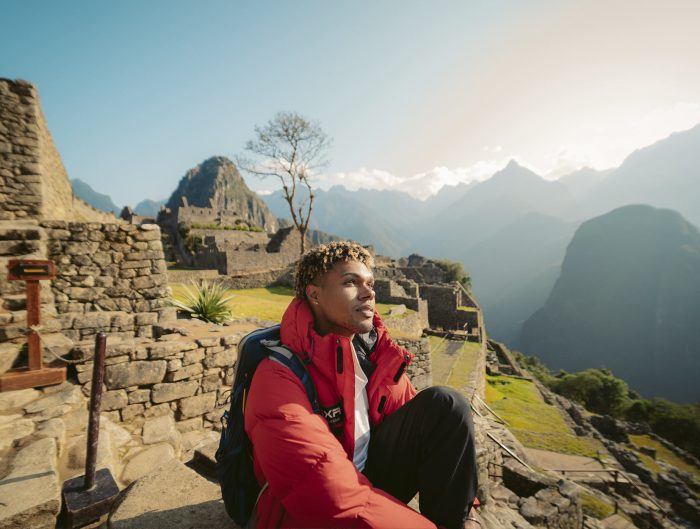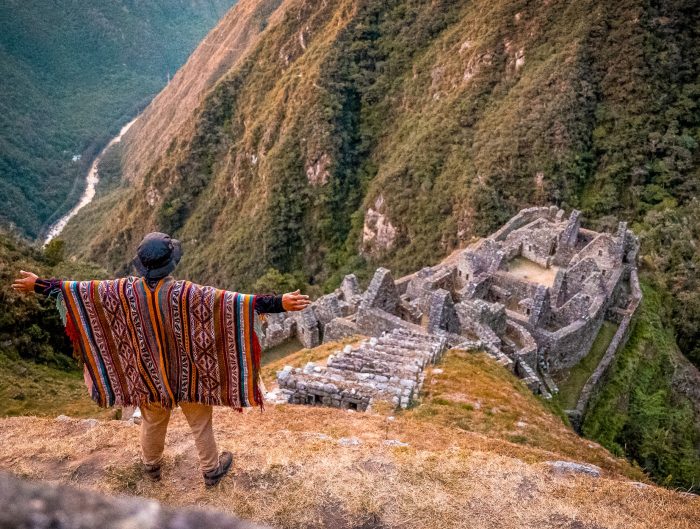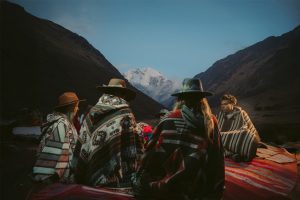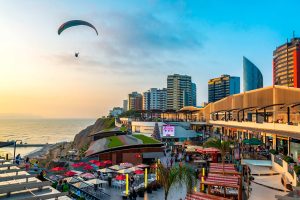The globally renowned Inca Trail in Peru connects to Machu Picchu and reveals extraordinary ancient Inca civilization archaeological sites. Each site tells a unique story, from the majesty of Machu Picchu to strategically positioned enclaves like Sayacmarca and the lush spirituality of Wiñay Wayna.
Discover how these Inca Trail sites transport us to an intriguing past filled with mysteries and wonders. Let’s embark on this journey!
What is the Inca Trail to Machu Picchu?
The Inca Trail to Machu Picchu is an ancient gem winding through the majestic Peruvian Andes, connecting modern adventurers with the grandeur of the Inca civilization. This iconic route is more than just a trail; it’s a journey through time, a spiritual experience, and a profound connection with nature.
This trek is a physical challenge and an immersion in history, where each step brings us closer to the essence of the Inca civilization. Its terraces, temples, and cobblestone roads narrate a millennia-old story, while the lush nature and towering landscapes highlight the majesty of this world heritage.

How Long Does the Inca Trail to Machu Picchu Take?
The classic Inca Trail trek usually spans 4 days, covering approximately 42 kilometers.
The Inca Trail Archaeological Sites
Llactapata
Llactapata is the first archaeological complex you’ll visit along the Inca Trail to Machu Picchu. Strategically located at 2,840 meters above sea level, it is known for its agricultural terraces. The name “Llactapata” translates to “High Town” or “Terraced Town” in Quechua. This Inca site was an agricultural and ceremonial center that controlled trade routes.
Extra Fact Llactapata was discovered by the American explorer Hiram Bingham in 1912, shortly after finding Machu Picchu.

Runkurakay
Runkurakay is an archaeological site known for its unique circular architecture. Its name in Quechua translates to “Pile of Ruins,” and it is believed to have served as a checkpoint, observation point, or even of a religious nature.
Located at 3,760 meters above sea level, Runkurakay represents the grandeur of the Inca civilization. Its distinctive architecture has been carefully restored and preserved, making it a portal to the past and a natural wonder in the majestic Peruvian Andes. You can enjoy breathtaking panoramic views of the ancient trail and explore the diversity of flora and fauna surrounding it—a genuinely essential stop on the Inca Trail hike to the mysterious Inca citadel of Machu Picchu.


Sayacmarca
Sayacmarca is an archaeological site renowned for its meticulous urban design. It is divided into two main parts: the Temple of the Sun and the residential area, consisting of a labyrinth of narrow corridors. The complex features a series of terraces, staircases, and water channels supplying the small areas within the site.
The Quechua name “Sayacmarca” translates to “Inaccessible Town,” reflecting its location on a mountain crest at 3,600 meters above sea level. It likely served as a citadel dedicated to agriculture. Sayacmarca stands as a testament to the advanced engineering and architecture of the Incas, making it a captivating destination for history and adventure enthusiasts. Like other archaeological sites, the only way to visit is through the Inca Trail.
Extra Fact // In 1915, Hiram Bingham discovered Sayacmarca, originally naming it “Cedrobamba.” The name underwent modification.


Phuyupatamarca
Phuyupatamarca is another impressive Inca ruin along the Inca Trail in Peru. The name “Phuyupatamarca” is derived from Quechua, meaning “City above the Clouds.” This name fits as the site is situated at a considerable altitude (3,600 meters above sea level), making it one of the highest archaeological sites Inca Trail.
Its construction is another excellent example of the Inca philosophy of perfect balance between humans and nature. This site consists of terraces carved into the mountainsides, enclosures, and ritual baths. What makes it even more fascinating is its advanced hydraulic system, which, even today, continues to function for irrigation within this historical complex.
Extra Fact // Phuyupatamarca is also an excellent viewpoint due to its elevation, providing views of Intipata and Wiñay Wayna.


Intipata
Intipata is one of the steepest and most impressive terrace sets along the Inca Trail. The site served as one of the many control points along the trail, offering a good vantage point to observe travelers on their way to Machu Picchu. They cultivated potatoes, corn, oca, quinoa, and coca leaves.
Its name, “Intipata,” translates to “Terrace of the Sun,” and this archaeological site is 2,840 meters above sea level. Intipata provides a unique opportunity to understand the importance of agriculture in Inca society and admire the impressive engineering and architectural work of the Incas in constructing agricultural terraces on mountainous terrain. It offers a unique experience for history and nature lovers alike.


Wiñay Wayna
Wiñay Wayna is one of the most impressive archaeological sites on the Inca Trail trek. Its located at 3,800 meters above sea levelis only 4 KM from Machu Picchu and serves as the last camping site on the trek to Machu Picchu. “Wiñay Wayna” means “Forever Young” in Quechua, the Incas’ language, honoring the area’s eternal beauty and freshness.
This archaeological site was a significant ceremonial and agricultural center during the Inca Empire. People believe that it served for religious activities and as a support point for growing food for travelers on the Inca Trail. Wiñay Wayna features a series of well-preserved stone structures, including agricultural terraces, residential buildings, fountains, and a temple. The agricultural terraces of Wiñay Wayna are an impressive example of the Incas’ skill in building agricultural systems on steep slopes.


Inti Punku
Inti Punku or “Sun Gate” serves as the entrance to the Machu Picchu citadel when embarking on the Inca Trail hike. On the final day of the trek, you can revel in truly breathtaking views of the ancient citadel and the surrounding mountains and valleys from this vantage point.
The Sun Gate is a stone structure on a ridge overlooking the Machu Picchu complex. It gets its name from the Inca sun god, Inti, and historians believe that the Inca people considered it a place of religious significance. The hike to the Sun Gate is relatively easy, lasting approximately 45–60 minutes, and offers impressive views of Machu Picchu from a different perspective. The Sun Gate is also a popular spot to watch the sunrise over Machu Picchu, providing visitors with a magical and unforgettable experience.
Extra Fact // Inti Punku was the site of rituals and celebrations related to worshiping the sun, one of the central pillars of the Inca religion. Solstices and equinoxes were crucial moments for these ceremonies.


Machu Picchu
And to finish with a flourish, we have the majestic Inca citadel of Machu Picchu. Classified as a Cultural and Natural Heritage of Humanity by UNESCO, Machu Picchu represents ancestral genius and harmony between humans and nature. Located at 2,400 meters between the Andes and the cloud forest, this archaeological site is a historical and ecological treasure.
To this day, the exact purpose of this citadel remains an intriguing mystery. Its temples, terraces, walls, palaces, and enclosures astonish visitors and experts. The meticulous construction and precision in stone craftsmanship leave most visitors speechless.

Inca Trail Frequently Asked Questions
Where is the Inca Trail located?
The Inca Trail is in Peru, connecting Cusco with Machu Picchu. The most well-known route starts at kilometer 82 of the Cusco–Aguas Calientes railway and culminates at the iconic citadel of Machu Picchu.
When is the Inca Trail closed?
The Inca Trail is closed every February for maintenance and conservation tasks. During this period, you won’t have access to this route, and we recommend checking the exact closure dates, as they may vary.
Why is the Inca Trail so popular?
The Inca Trail is popular for its unique combination of natural beauty, Inca history, and the challenge of reaching Machu Picchu through stunning landscapes, offering adventurers an exclusive and mystical experience.
Is a guide required for the Inca Trail?
Yes, it is mandatory to have an authorized guide for the trek. This ensures safety and site preservation.
Is Inca Trail dangerous?
The Inca Trail is generally not considered dangerous; however, adventurers must take precautions and adequately prepare to ensure a safe experience.
The Wonders of the Inca Trail
Reaching Machu Picchu via the Inca Trail should be on your wishlist if you are an adventurous traveler. This impressive hike through its archaeological sites exemplifies an adventure that cannot be described with words alone. It’s an ancestral journey, connecting you with this sacred place’s essence. Are you ready to discover it?















Leave A Reply